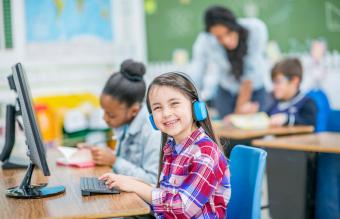
Montessori theory is a revolutionary style of teaching that focuses on giving a child a well-rounded education - one that includes more that just academics. This means that your child is not just learning mathematics and language arts, but also skills that allow them to function in the real world.
Maria Montessori created this educational approach in the early 1900s and it has stood the test of time for a reason. If you want to learn more about Montessori theory and the Montessori principles that encompass this type of instruction, we give you a glance at this revered teaching method.
What Is Montessori Theory?
Montessori theory is an educational approach that circles around the belief that children naturally want to learn. When they are presented with the right tools in an accessible space, they will make connections and be excited to engage in educational activities.
The American Montessori Society notes that this method of teaching is "student-led and self-paced but guided, assessed, and enriched by knowledgeable and caring teachers, the leadership of their peers, and a nurturing environment."
A Montessori education not only encourages a love of learning. It has also been proven to foster creativity, build independence, and bolster academic success.
The 6 Main Montessori Principles
A Montessori education is a non-traditional approach to learning. It puts the child in the driver's seat and allows them to learn in their own unique way. Here are the leading principles of the Montessori method.
Hands-On Learning
Hands-on learning is one of the prime pillars of a Montessori education. Activities that engage a child's senses and allow them to experiment foster cognitive development and build their social skills. Every Montessori activity involves a child learning through observation and application.
This style of teaching allows a child to recognize and correct their mistakes, in turn, learning how to successfully complete a task on their own.
A Prepared Environment
One of the big differences between a regular classroom and a Montessori one is that the Montessori classroom prioritizes simplicity, accessibility, and organization. Toys and activities are displayed in low, open cabinets. This gives the children access to everything. Each item has its own space. There is no clutter, and the toys require the use of children's hands, minds, and imaginations.
There are no flashy lights or attention grabbing sounds. They are practical items that facilitate learning and creative play. A Montessori style space also utilizes "work mats" or rugs to keep kids better focused on each task.
Freedom (With Reasonable Limits)

Maria Montessori believed that children learn best when they have the freedom to choose their own task and engage in that activity as they see fit. In a Montessori classroom, guided activities are presented throughout the day, but it is the child's choice to partake in the task, to simply observe, or engage in something else entirely.
One of the main reasons that children have meltdowns is that they lack a sense of control. By allowing them to freely choose how they learn, you make learning more enticing and they will more effectively absorb and understand the information being presented.
Respect & Observation
Every child is unique. They all have their own set of talents and they all learn at their own speed. By having respect for the child, the teacher can observe each student, assess their inherent strengths, and better address their individual needs.
This can differ from traditional classrooms where children are all expected to advance at the same pace, which can many times leave children being left behind.
One of the things that I love most about Montessori education is that fact that it is inclusive. This means that children with disabilities and neurodivergences are welcomed in the classrooms. My son experienced severe hearing loss until surgery just before his third birthday. He was turned away from another school due to this hearing deficit. We then enrolled him in a Montessori program that welcomed him with open arms and provided him with the support he needed to thrive.
Independence
Another main pillar of the Montessori theory is teaching a child to be self-sufficient. This is why a prepared environment is so important. It allows a child to access the materials they want and put them away when they are done.
It also gives them the opportunity to contribute to the classroom, or for those who do Montessori at home, help out the household. The goal is to help them learn to think for themselves, problem solve, and become confident human beings.
Learning Happens Through Play
Maria Montessori also believed that learning was its own reward. This is why Montessori toys and activities are tailored to keep a child interested and allow for natural learning opportunities.
They involve movement, they stimulate the senses, and they cater to all learning styles. That means that no matter if your child is a visual, tactile, or auditory learner, there are opportunities to help them take in the information in the most effective way possible.
Montessori Values Teach Skills for a Lifetime
Montessori theory also supports the idea of teaching the whole child. On top of teaching them practical life, language, sensorial (colors, textures, shapes, etc.), mathematical, and cultural skills, they also foster opportunities for physical, emotional, and social development. While non-traditional, research shows that this learning style improves the confidence and well-being of a person into adulthood.







